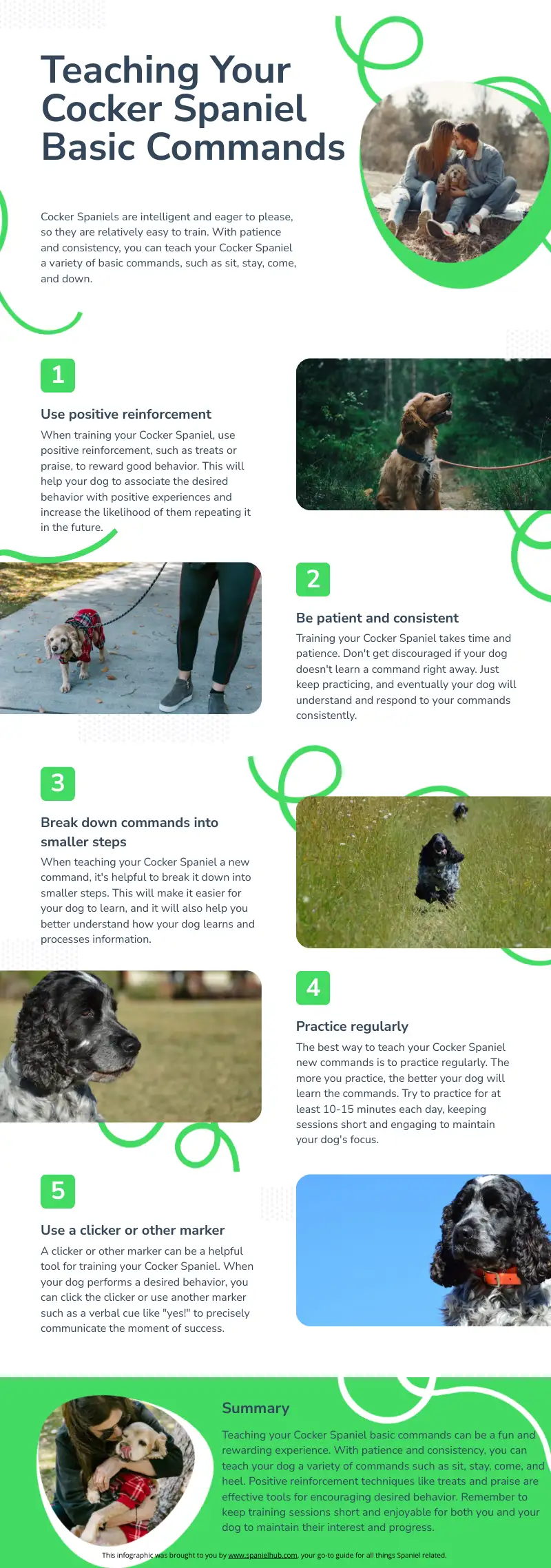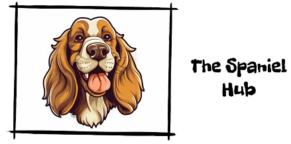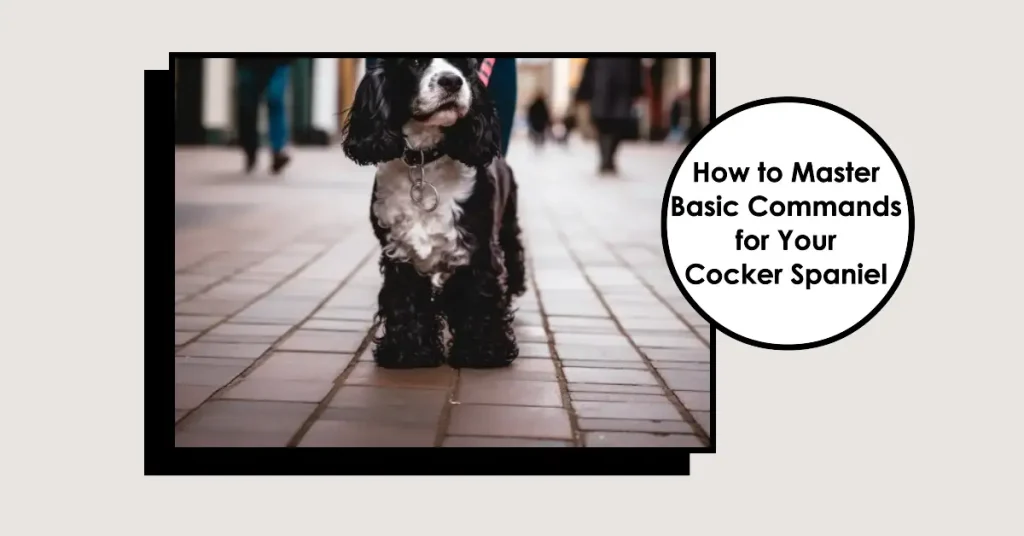Table of Contents
As a dog lover, you know the importance of training your Cocker Spaniel. Teaching them basic commands not only ensures their safety but also strengthens your bond. Let’s dive into the world of Cocker Spaniel training and uncover the benefits of teaching these adorable dogs basic commands.
We will discuss this topic further in the following paragraphs…
Exploring the Cocker Spaniel’s temperament
A Cocker Spaniel’s natural instincts and traits play a vital role in the training process. They are intelligent, eager to please, and have a strong desire to work with their human companions. Keep these traits in mind, and let’s explore some tips for successful training.
Natural Instincts and Traits
Cocker Spaniels are known for their hunting instincts, as they were originally bred to flush out game birds. Their intelligence and keen senses make them excellent working dogs, but these traits also require mental stimulation and regular exercise. Understanding their instincts will help you tailor your training approach to their unique temperament.
- Intelligence: Cocker Spaniels are quick learners and can easily pick up on new commands and behaviors. Make use of their intelligence by keeping training sessions engaging and challenging.
- Eagerness to please: Their desire to make their human happy is a valuable trait in training. Use this to your advantage by providing positive reinforcement and praise when they exhibit desired behaviors.
- Sensitivity: Cocker Spaniels can be sensitive to harsh training methods. Always use positive reinforcement techniques and avoid punishment to prevent potential setbacks.

Tips for Successful Training
- Establish trust: Building a strong bond with your Cocker Spaniel is the foundation of successful training. Spend quality time with them and learn to understand their body language and signals.
- Start early: Begin training and socialization as early as possible. Young puppies are more receptive to learning new commands and behaviors, making it easier to establish good habits from the start.
- Short, consistent sessions: Conduct multiple short training sessions throughout the day, rather than one long session. This helps keep your Cocker Spaniel’s attention and prevents them from becoming overwhelmed.
- Patience: Progress may not always be linear, and setbacks are common in dog training. Be patient and remember that your Cocker Spaniel wants to please you. With time and consistency, they will learn the desired behaviors.
Essential training tools and techniques
Clicker training, positive reinforcement, consistency, and patience are crucial when teaching your Cocker Spaniel. Reward their good behavior with treats, praise, and playtime to keep them motivated.
Clicker Training
Clicker training is a popular method that uses a small device that makes a clicking sound as a marker for desired behaviors. This method is based on operant conditioning and can help speed up the learning process.
- Timing: Click the moment your Cocker Spaniel performs the desired behavior, followed by a reward. This helps them associate the click with the correct action.
- Charging the clicker: Before starting any training, familiarize your dog with the clicker by clicking and rewarding them with a treat, even if they haven’t performed a specific action. Repeat this several times to create a positive association with the clicker.
- Progressive training: Begin with simple commands and gradually move on to more complex tasks, always marking the desired behavior with a click and a reward.
Positive Reinforcement
Positive reinforcement is a crucial aspect of successful dog training. This approach focuses on rewarding desired behaviors, which encourages your dog to repeat them.
- Treats: Use small, soft treats that your Cocker Spaniel enjoys. These should be easy to chew and swallow, and small enough to avoid overfeeding.
- Praise: Verbal praise and affection can be just as motivating as treats. Use a happy, enthusiastic tone to encourage your dog.
- Playtime: Incorporate playtime as a reward during training sessions. This can help maintain your dog’s interest and strengthen your bond.
Consistency and Patience
Consistent training is crucial for your Cocker Spaniel to understand and retain the commands being taught.
- Set a schedule: Establish a regular training schedule, with multiple short sessions each day.
- Use consistent cues: Ensure that all family members use the same verbal and visual cues for each command.
- Patience: Training takes time, and progress may not always be linear. Be patient with your Cocker Spaniel and remember that they are eager to please.

Cocker Spaniel Basic Command 1: Sit
Teaching your Cocker Spaniel the “sit” command is an essential first step in their training journey. This foundational command helps establish trust and communication between you and your dog. Here’s how to teach the “sit” command effectively.
How to Teach the Command
- Get their attention: Ensure your Cocker Spaniel is focused on you before starting the training session. You can do this by calling their name or simply making eye contact.
- Use a treat: Hold a treat above your dog’s nose and slowly move it back towards their tail. As their head follows the treat, their bottom will naturally touch the ground.
- Introduce the cue: Once they’re in the sitting position, say “sit” in a clear, firm tone.
- Reward: Immediately reward them with the treat and offer praise to reinforce the positive behavior.
- Practice: Repeat this process several times throughout the day, gradually reducing the reliance on treats as your Cocker Spaniel becomes more proficient.
Common Mistakes and How to Avoid Them
- Pushing their bottom down: Avoid physically pushing your dog’s bottom to the ground, as this could create confusion and resistance. Instead, use the treat to guide them into the sitting position.
- Inconsistent cues: Ensure that everyone in your household uses the same verbal cue and hand signal for the “sit” command. Consistency is key for your Cocker Spaniel to understand and respond to the command.
- Delaying rewards: Timing is essential when rewarding your dog for sitting. Be sure to provide the treat and praise immediately after they sit, so they understand the connection between the behavior and the reward.
Cocker Spaniel Basic Command 2: Stay
Teaching your Cocker Spaniel the “stay” command is important for their safety and self-control. This command helps them understand when to remain in one spot, despite potential distractions. Here’s how to effectively teach the “stay” command.
Training Steps
- Start in the “sit” position: Have your Cocker Spaniel sit before introducing the “stay” command. This helps establish a starting point and ensures they are focused on you.
- Introduce the cue: Hold your hand up with your palm facing your dog, and say “stay” in a clear, firm tone.
- Take a few steps back: Slowly take a few steps back from your dog, maintaining eye contact and the hand signal. If they remain in place, return to them and reward them with a treat and praise.
- Gradually increase distance and duration: As your Cocker Spaniel becomes more proficient, increase the distance between you and your dog, as well as the duration of the “stay” command.
- Practice with distractions: Once your dog can reliably stay in place, introduce distractions, such as other people or animals, to ensure they can maintain the “stay” command in various situations.
Overcoming Potential Challenges
- Patience: If your Cocker Spaniel struggles with the “stay” command, remember to be patient and consistent in your training. This command may take more time to master, especially in the presence of distractions.
- Consistency: Ensure all family members use the same verbal cue and hand signal for the “stay” command. This consistency helps your dog understand and respond to the command more effectively.
- Avoid calling them to you: When practicing the “stay” command, always return to your dog to reward them rather than calling them to you. This helps avoid confusion between the “stay” and “come” commands.
Cocker Spaniel Basic Command 3: Come
Teaching your Cocker Spaniel the “come” command, also known as recall, is crucial for their safety and your peace of mind. A reliable recall ensures your dog will return to you when called, even in potentially dangerous or distracting situations. Here’s how to effectively teach the “come” command.
Training Steps
- Choose a reward: Select a high-value treat or a favorite toy that your Cocker Spaniel is particularly fond of. This will help motivate them to respond to the “come” command.
- Call their name: Begin by calling your dog’s name in a cheerful tone, ensuring you have their attention.
- Introduce the cue: After saying their name, add the word “come” in an upbeat, enthusiastic tone. This will help create a positive association with the command.
- Reward: When your dog approaches you, immediately reward them with the treat or toy, and offer praise and affection.
- Practice: Repeat this process in various environments, such as indoors, outdoors, and in areas with distractions. This helps ensure your Cocker Spaniel can reliably respond to the “come” command in any situation.
Strengthening Recall
- Gradual progression: Start training in a low-distraction environment, such as your home or a fenced yard. Gradually progress to more challenging environments as your dog becomes more proficient in recall.
- Long leash training: Use a long leash or training lead to practice recall at greater distances while still maintaining control of your dog.
- Avoid punishment: Never punish your dog when they return to you, even if they took longer than you would have liked. Punishment can create a negative association with the “come” command, making your dog less likely to respond in the future.
Cocker Spaniel Basic Command 4: Down
Teaching your Cocker Spaniel the “down” command helps establish control and manners, making it easier to manage your dog in various situations. It’s an essential command that requires patience and persistence to ensure success. Here’s how to effectively teach the “down” command.
Training Steps
- Start in the “sit” position: Have your Cocker Spaniel sit before introducing the “down” command. This helps create a clear starting point and ensures they are focused on you.
- Use a treat: With a treat in hand, guide your dog from the “sit” position to the “down” position by slowly lowering the treat to the floor. Your dog should follow the treat with their nose and lie down.
- Introduce the cue: Once your dog is lying down, say “down” in a clear, firm tone.
- Reward: Immediately reward them with the treat and offer praise to reinforce the positive behavior.
- Practice: Repeat this process several times throughout the day, gradually reducing the reliance on treats as your Cocker Spaniel becomes more proficient.
Avoiding Confusion with Other Commands
- Differentiate “down” and “off”: Make sure not to confuse the “down” command with the “off” command, which is used to discourage jumping or climbing on furniture. Use distinct verbal cues and hand signals for each command to prevent confusion.
- Consistent cues: Ensure all family members use the same verbal cue and hand signal for the “down” command. This consistency helps your dog understand and respond to the command more effectively.

Cocker Spaniel Basic Command 5: Heel
Teaching your Cocker Spaniel the “heel” command is essential for controlled, enjoyable walks without pulling or lagging behind. When properly trained to heel, your dog will walk by your side, maintaining a steady pace and paying attention to your movements. Here’s how to effectively teach the “heel” command.
Training Steps
- Start with the proper position: Have your Cocker Spaniel sit on your left side, facing the same direction as you. This position helps establish the correct walking alignment.
- Introduce the cue: Begin walking, and as you do, say “heel” in a clear, firm tone. You may also use a hand signal, such as tapping your left thigh, to reinforce the command.
- Reward: If your dog stays by your side, maintaining a steady pace and not pulling on the leash, reward them with a treat and praise. Be sure to reward them frequently during initial training to reinforce the desired behavior.
- Practice: Frequent practice is essential for mastering the “heel” command. Incorporate it into your daily walks and gradually reduce the frequency of treats as your Cocker Spaniel becomes more proficient.
Tips for Success
- Use a short leash: A shorter leash helps maintain control and keeps your dog close to you during the training process.
- Change direction: If your dog begins to pull or lag behind, abruptly change direction and use the “heel” command to encourage them to follow. This helps teach them to pay attention to your movements and maintain the proper position.
- Be patient: The “heel” command can take time to master, especially for energetic breeds like Cocker Spaniels. Be patient and consistent in your training, and remember to offer plenty of praise and rewards for a job well done.
Socialization and Behavior Training
Socialization is not merely a component but the very foundation of nurturing a well-rounded Cocker Spaniel. By immersing your dog in diverse settings, introducing them to a spectrum of individuals, and facilitating interactions with various animals, you’re not just teaching them etiquette but also fostering resilience, self-assurance, and adaptability. Merging socialization with behavioral training doesn’t just enhance their mental and emotional health but also fortifies the bond you share.
Acclimatizing to Varied Environments
- Progressive Adaptation: Start by methodically introducing your Cocker Spaniel to an array of settings, from tranquil parks to bustling urban streets and welcoming pet-centric establishments. This systematic approach ensures they grow accustomed to and eventually thrive in a multitude of scenarios.
- Affirmative Reinforcement: Utilize a combination of treats, verbal commendation, and physical affection to underscore and reward desired behaviors. This not only reinforces good conduct but also ensures your dog associates novel experiences with positive outcomes.
- Decoding Canine Communication: It’s imperative to be attuned to your dog’s non-verbal cues. Recognizing signs of discomfort or anxiety allows you to offer timely comfort and adjust the pace of exposure accordingly.
Interactions with Diverse Individuals and Animals
- Structured Social Sessions: Organize play sessions with other dogs, ensuring beforehand that their temperaments and play behaviors are harmonious. This not only offers a fun outlet but also educates your Cocker Spaniel about the nuances of canine interaction.
- Broadening Human Interactions: Ensure your dog meets people from all walks of life, encompassing different ages, physiques, and attire, including those with mobility aids. This holistic exposure diminishes the likelihood of apprehension or hostility towards unfamiliar faces.
- Cultivating Courteous Greetings: Train your Cocker Spaniel to approach and greet newcomers in a composed manner, curbing tendencies like overenthusiastic jumping or unwarranted vocalizations.
Sustained Socialization Efforts
- Regular Engagements: Socialization isn’t a one-time endeavor. Consistently introducing your Cocker Spaniel to fresh experiences is pivotal in preserving their refined manners and adaptable nature.
- Collective Training Sessions: Participating in group training sessions serves a dual purpose. While it aids in instilling basic commands, it also offers a platform for your dog to mingle with other canines and their human companions.
- Vigilant Supervision: As you navigate through various socialization scenarios, remain alert to your dog’s behavior. Addressing any anomalies or concerns promptly ensures they don’t solidify into long-term behavioral challenges.
Troubleshooting Common Training Issues
Training a Cocker Spaniel can sometimes present challenges, such as stubbornness or distractibility. However, with patience, consistency, and a few helpful strategies, you can effectively address and overcome these common training issues.
Dealing with Stubbornness
- High-value rewards: If your Cocker Spaniel is stubborn, consider using high-value treats or toys to capture their attention and motivate them to follow commands. This can be particularly helpful during the early stages of training.
- Short training sessions: Keep training sessions brief and engaging to prevent your dog from becoming bored or disinterested. Aim for 10-15 minute sessions, multiple times a day.
- Patience and consistency: Stay patient and consistent in your approach, even when faced with stubborn behavior. Over time, your Cocker Spaniel will learn that cooperation yields positive results.
Addressing Distractibility
- Change training locations: To help your Cocker Spaniel focus during training, try changing locations periodically. This can help keep their interest piqued and prevent them from becoming too comfortable or bored in a single location.
- Minimize distractions: During initial training, choose environments with minimal distractions to help your dog focus on you and the task at hand. As they become more proficient, gradually introduce more challenging environments to improve their focus and adaptability.
- Use cues and signals: Utilize clear verbal cues and hand signals to help your dog understand and follow commands. This can help maintain their attention and promote successful training.
Remembering the Importance of Ongoing Training
- Continuous reinforcement: Training is an ongoing process, and it’s essential to continue reinforcing commands and behaviors throughout your dog’s life. This helps maintain their skills and prevents regression.
- Adapt training to your dog’s needs: As your Cocker Spaniel ages or experiences changes in their health, you may need to adjust your training approach to accommodate their unique needs. This ensures they remain engaged and successful in their training.

Continuing Education and Advanced Commands
Ongoing training is not only crucial for maintaining your Cocker Spaniel’s obedience and manners but also plays a significant role in their mental stimulation and growth. Engaging your dog in advanced training and dog sports can help build a stronger bond, provide a fun outlet for energy, and challenge them mentally and physically.
Advanced Obedience Classes
Enrolling your Cocker Spaniel in advanced obedience classes can help build on their basic training foundation, introducing new commands and refining existing ones. These classes often focus on off-leash control, distance commands, and advanced behaviors such as retrieving objects, heeling with turns, and more. Participating in advanced obedience classes can help keep your dog engaged and well-behaved.
Dog Sports and Activities
Exploring dog sports and activities can provide your Cocker Spaniel with an enjoyable, challenging outlet for their energy and intelligence. Some popular dog sports that are well-suited for Cocker Spaniels include:
- Agility: Agility courses challenge your dog to navigate a series of obstacles, such as jumps, tunnels, and weave poles, under your guidance. This sport promotes teamwork, focus, and physical fitness.
- Flyball: Flyball is a relay race in which teams of dogs compete to retrieve a tennis ball and return it to their handler. This fast-paced sport helps build speed, agility, and teamwork skills.
- Rally Obedience: Rally Obedience (Rally-O) is a fun spin on traditional obedience, where dog-handler teams navigate a course with various stations featuring obedience tasks. This sport encourages precision, focus, and the development of a strong handler-dog partnership.
Lifelong Learning and Bonding
Continuing education and advanced commands help create a well-rounded, mentally stimulated Cocker Spaniel. As you engage in these activities, you’ll not only improve your dog’s skills and behavior but also strengthen the bond you share. By prioritizing ongoing training and exploration of new challenges, you’ll ensure your furry companion leads a fulfilling, engaging life.
Conclusion: Cocker Spaniel Basic Commands
Celebrate your Cocker Spaniel’s progress and enjoy the journey of training your canine companion. A well-trained Cocker Spaniel will not only be a joy to have around but will also develop a strong bond with you, making your life together even more fulfilling. With patience, consistency, and dedication, you and your Cocker Spaniel will master these basic commands and pave the way for a lifetime of happiness and companionship.
COPYRIGHT NOTICE
Please be advised that all images, designs, and creative content on this page are the exclusive property of Spanielhub.com and are protected under international copyright laws. The images may not be reproduced, copied, transmitted or manipulated without the written permission of Spanielhub.com.
Unauthorized use, distribution, display, or creation of derivative works of any images contained on this page, is strictly prohibited and can lead to legal penalties. We actively monitor for, and enforce, our copyright interests.
If you wish to use any of our images, kindly contact us to seek permission. Respect of copyright is not merely a legal requirement but also an acknowledgement and support of the hard work and creativity that goes into producing them.
Thank you for your understanding and cooperation.
© 2023, Spanielhub.com. All Rights Reserved.
Last update on 2024-04-15 / Affiliate links / Images from Amazon Product Advertising API







